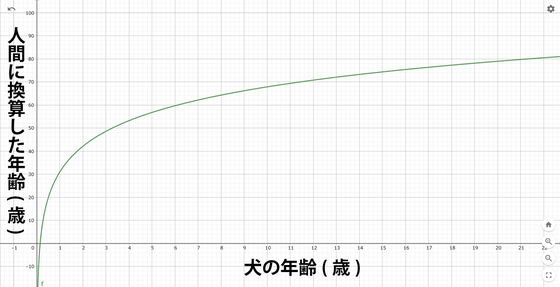A new formula for converting the age of dogs to humans has appeared, how old are 1-year-old dogs?

by
Dogs have a life expectancy of around 15 years and are much shorter than humans with a life expectancy of 80 years. Also, because dog growth and aging are at a different pace from humans, it is difficult to simply convert dog age to human age. Therefore, a new formula has been devised to analyze the aging of dogs that are difficult to understand at the DNA level, and to ask ' how many years will it be when the age of a dog is converted to a human being? '
Quantitative translation of dog-to-human aging by conserved remodeling of epigenetic networks | bioRxiv
https://www.biorxiv.org/content/10.1101/829192v2
'Dog Years' Are a Total Myth. Here's How Old Fido Really Is. | Live Science
https://www.livescience.com/dog-age-equation.html
In the past, the calculation of “multiplying the age of a dog by 7” was used as a method to find “how much is the age of a dog if it is a human being”. According to this calculation, a 1 year old dog is equivalent to a human being 7 years old, a 5 year old dog is equivalent to a human being 35 years old, and a 10 year old dog is equivalent to a human being 70 years old. However, the pace of growth and aging differs between dogs and humans. Therefore, simply multiplying by 7 does not mean that the dog's growth is correctly grasped.

by
Therefore, a research team at the University of California, San Diego , proposed a method that uses DNA methylation to define aging. DNA methylation is a chemical reaction in which a methyl group (—CH 3 ) is added to some of the carbon atoms that make up DNA. Previous studies have shown that DNA methylation tends to progress with age and occurs not only in humans but also in dog DNA.
The research team collects blood samples from approximately 100 dogs aged 1 to 16 years and analyzes the DNA. And we compared it with DNA methylation data obtained by analyzing 320 people from 1 to 103 years old.
As a result, it turned out that on average, “8 weeks of a dog is equivalent to about 9 months of a human being”. However, the progression rate of DNA methylation in dogs is different from that of humans, researching `` The progression rate of DNA methylation in dogs is faster than humans when you are young and approximates the progression rate of humans as you age. '' The team is arguing.
Based on the results of this research, the research team announced the formula “ 16 x log e (dog age) + 31 = age in terms of humans ”. A graph of this formula is the following image, the horizontal axis is the actual age of the dog, and the vertical axis is the age converted to humans. According to this, one year old dog is 31 years old, 5 years old is about 57 years old, and 10 years old is about 68 years old.

However, most of the dogs that collected blood samples in this study were Labrador Retrievers . For this reason, the research team says, “If the breed is different, this formula may not be fully valid,” he says.
Related Posts:







